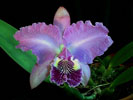|
|
|
|
|
| |
Flasks of
Cattleya lueddemanniana 'CedarWood Splendor' × self |
|
| |
|
|
| |
| Number: |
TN2933 |
| Name: |
Cattleya lueddemanniana 'CedarWood Splendor' × self
|
| Type: |
self (What's that?) |
|
Seed Donor: |
CJ Maciejeski
|
|
Click to Enlarge

Pod Parent Flower |
Click to Enlarge

Pod Parent Closeup of Column |
|
|
|
| |
Culture Notes from Donor: A warm-growing, lowland species, Cattleya lueddemanniana will sulk and prove reluctant to flower in the conditions preferred by its high-elevation Andean cousins.
Parent plant: Temperature range W (70-90°F)
Comments: Parent plant: Large plant. A fine example of this lowland Venezuelan species, this plant is the result of a selfing of the cultivar 'Cursons' at Stewart Orchids. All segments deep, concolor sparkling violet-pink; dorsal sepal reflexed at distal tip, veins prominent; lateral petals very full, well held, attractively ruffled along edges, slightly reflexed at tips; lateral sepals moderately falcate, prominently veined; labellum full, quite exquisitely marked deep magenta on midlobe, two prominent golden eyes at opening of throat, edged in white, prominent pale yellow nerves radiating from throat across disc; substance good for the species; texture sparkling. A distinguishing feature of the species is the curious winged process on the tip of the column over the anther cap. This appendage is illustrated in the internal photograph of the labellum. This feature of column structure is unique among labiate cattleyas, with most other species having nothing more than a hook-like process over the anther cap.
For additional origin/habitat information supplied courtesy of
Charles and Margaret Baker, see further below, near the bottom of this page.
|
Temperatures we attempt to use in the lab & greenhouse:
| For Species: |
|
Spring, Summer, Autumn, Winter: days average 90°F, nights 70°F; best fit is Warm 90-70°F
(Source:
Baker's Web OSC) |
| For Genus: |
|
Spring, Summer, Autumn, Winter: days average 83°F, nights 60°F; best fit is Intermediate 83-60°F
(
) |
|
About the name...
| Etymology of |
Cattleya |
|
Named in honor of William Cattley, English horticulturist in the 19th century.
(Source:
Pridgeon 1992) |
| Etymology of |
lueddemanniana |
|
Named for Lueddemann, French orchid gardener of the 19th century.
(Source:
Mayr & Schmucker 1998) |
| Pronunciation of |
Cattleya |
|
KAT-lee-ya
(Sources:
Pridgeon 1992, Hawkes 1978) |
| Pronunciation of |
lueddemanniana |
|
loo-ed-e-man-ee-AH-na
(Source:
Hawkes 1978) |
|
If you would like to direct someone to this web page, please copy and paste this URL into your email:
http://troymeyers.com/d?012933
| Flask Information |
| Availability: |
Capsule failed. We were not able to make any flasks. |
| You should: |
Consider placing a "Notify Retries" Request, and if an identical pollination (the same parents) is done again, we'll let you know. |
|
You might also want to:
|
View items of the same species.
View items of the same genus.
|
| Ordering Information |
| You are not currently logged in. |
|
You must be a registered user and be logged in to reserve a flask or place a notification request. Please log in:
|
|
|
|
|
|
| |
The origin/habitat information below is supplied courtesy of Charles and Margaret Baker
The following information is based on the name of the plant provided by the donor, and assumes that the name is correct. If the plant has been misidentified, then the following information may not be correct.
This text is copyrighted by the Bakers and may not be reproduced without permission.
ORIGIN/HABITAT: Venezuela. Plants grow on the north-facing slopes of the
central coast, usually west of Caracas. They are also found in fairly low
scrubby hills between San Felipe and Barquisimeto. Plants normally grow
between sea level and 1500 ft. (0-460 m), but they have been reported as
high as 2600 ft. (800 m).
More about this information and the Bakers...
|
|
|
| |
|
|
|